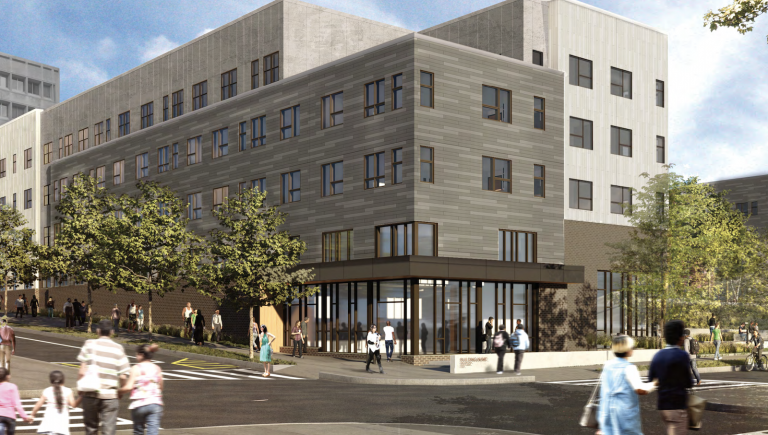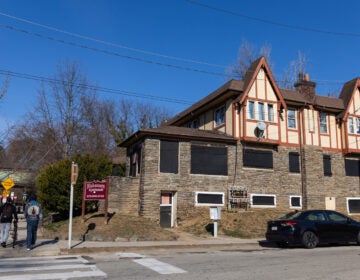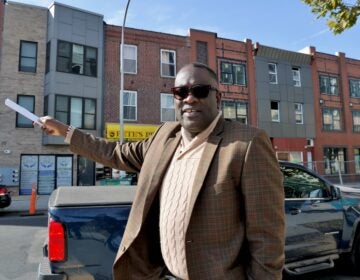A North Philly development supported by Obama will break ground this fall
This fall, North Philly will watch as ground is broken on the final phase of a $120 million redevelopment.

An artist's rendering of the new Norris Homes development as seen from 10th and Berks streets. (Jonathan Rose/ WRT)
Soon after Norris Homes opened in the 1950s, the public housing complex came under fire for the way it cut off residents from the surrounding North Philadelphia community.
Covering multiple city blocks, this Philadelphia Housing Authority neighborhood struggled with the same constraints as public housing across the country. Too isolated, too concentrated, too bleak.
One contemporary observer, John Bauman, a historian, described the “spartan” homes as a design fail, “grimly fronting the street.”
The old buildings are gone now, razed to make way for a modern, mixed-income, mixed-use project designed to blend into the gentrifying neighborhood around it.
And this fall, North Philly will watch as ground is broken on the final phase of a $120 million redevelopment that neighbors and housing authority officials alike hope will make their community whole again.
“This area sat in the middle of Temple, but was somewhat disconnected from it,” said Kelvin Jeremiah, president and CEO of the Philadelphia Housing Authority. “What you are seeing now is the reintegration of the neighborhood into not only the streetscape, but into what is happening in the area. The new housing going up around Temple is indistinguishable from our housing.”
The redevelopment will sprawl beyond the old confines of the original public housing. The old Norris Homes were located to the west of SEPTA’s Temple University Regional Rail stop, but the new development includes additional housing to the east of the stop too.
At the site of the new Norris Homes, commercial storefronts will open on Berks Street, enlivening a busy commuter corridor. Public green space will line 10th Street, bringing new activity to previously isolated blocks.
Residents have already begun moving back in to the homes created in the earlier phases of the redevelopment. The housing authority guarantees right-to-return to all those displaced by the demolition of the original Norris Homes.
Tenant leaders say that almost all of the families are planning on moving back to the area.
“Most residents I know have chosen to come back,” said Donna Richardson, president of the Norris Homes tenant council. “It was almost embarrassing to live here before, even if you were working or keeping a clean home. Now the buildings don’t stick out like a sore thumb. Everyone will want to live in these buildings we are living in. We can have pride and hold our heads high.”
Gone are the barracks-style homes, to be replaced by a large mixed-use apartment building on the south side of the block and a cluster of townhomes, with a surface parking lot, on the northern end. The site includes swathes of green space, barbeque pits, and a “flexible play area.”
“We are trying to blend with the surrounding neighborhood, while what was there previously felt like its own isolated pocket”.,” said Marissa Hebert, an architect at Wallace Roberts & Todd, the architecture firm working with PHA and Jonathan Rose Companies, the project’s developer.
The Norris redevelopment plan began in 2014, when the housing authority secured a $30 million implementation grant from the Obama administration’s Choice Neighborhoods program. Obama sought to reverse the isolation and segregation that typified traditional public housing developments while addressing the problems that came with reforms of the1990s, which saw thousands of public housing units destroyed and families displaced.
The Norris Homes overhaul is part of the housing authority’s larger shift away from the traditional public housing program, which suffered systemic disinvestment by Congress for decades. When PHA began the project, the authority strained beneath a $1.5 billion capital repair backlog. The Norris Homes alone needed $29 million in 2019 dollars for repairs.
The previous four phases of the project included small clusters of homeownership units along with large tracts of new affordable rental housing, with a mixture of income requirements, to the north.
The original Norris Homes complex included 147 units of permanently affordable public housing, and the redevelopment program commits to one-for-one replacement of those units at the same level of affordability. In earlier public housing redevelopment schemes, like Bill Clinton’s HOPE VI program, there was no one-for-one replacement requirement; as a result, Philadelphia lost 30% of its public housing stock.
“We are not displacing our residents and we are not reducing the number of affordable housing in that area, in fact we are adding affordable units to the neighborhood because we saw increasingly unaffordable homes in that area,” said Jeremiah.
The new homes in this last phase are a mix of housing types and affordability requirements. A new apartment building on the southern side of the site will host studios, one bedrooms, and two-bedroom apartments. Townhouses with three bedrooms will be on the northern end of the site. The development is expected to be complete in 2021
The affordability mixture will include 22 units of market rate housing, 66 units will be funded by the Low-Income Housing Tax Credit (LIHTC) and will be set at 60 percent of area median income, about $54,000 for a family of four.
Another 45 units will be funded through the Rental Demonstration Project (RAD), a federal program that brings private dollars and management to traditional public housing for a set period of time. The project is receiving rapturous reviews.
“It’s so beautiful, it looks like you are rich even if you are poor,” Richardson said.
Architects and developers with the city’s Civic Design Review Board praised its buildings materials and site design, while Asociacíon Puertorriqueños en Marcha (APM), which developed nearby Paseo Verde with Jonathan Rose, said the project is modernizing the area and making it easier to develop infill projects on vacant lots in the community.
WHYY is your source for fact-based, in-depth journalism and information. As a nonprofit organization, we rely on financial support from readers like you. Please give today.







